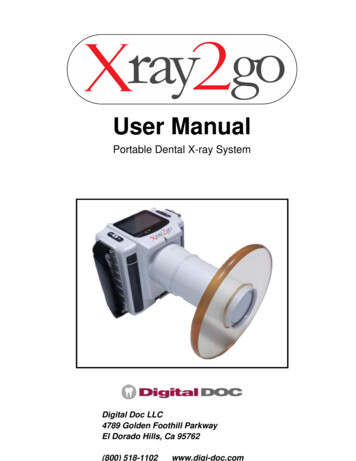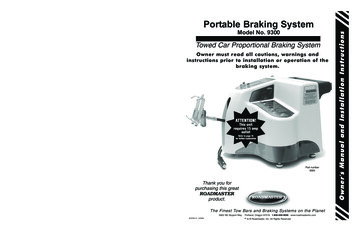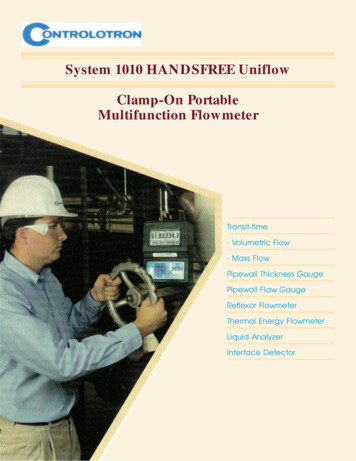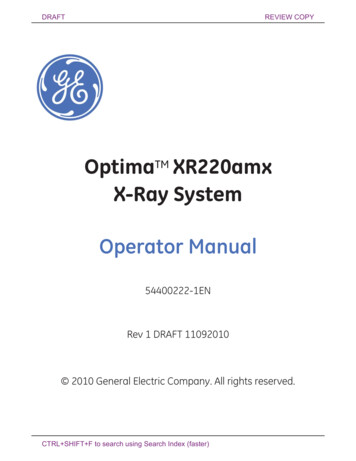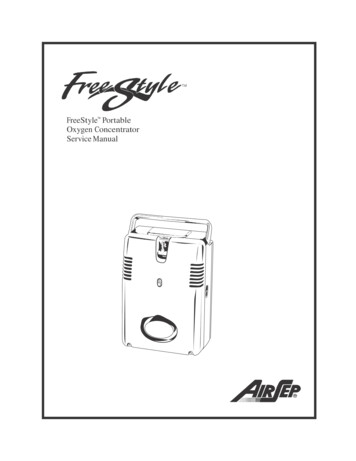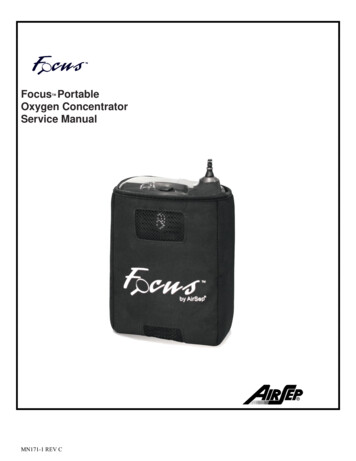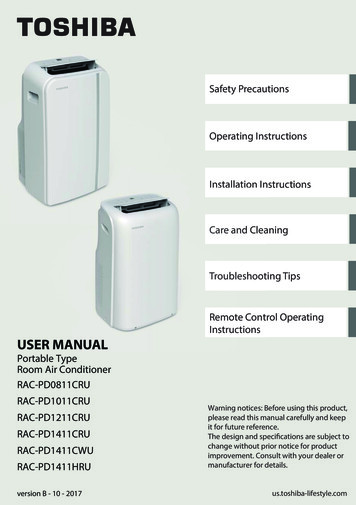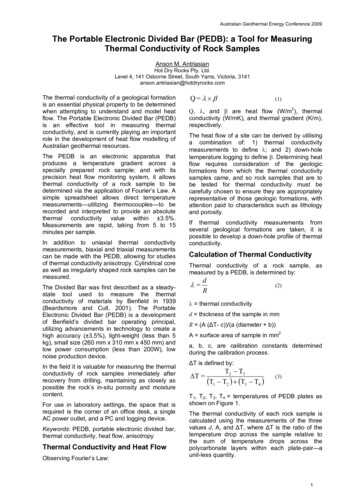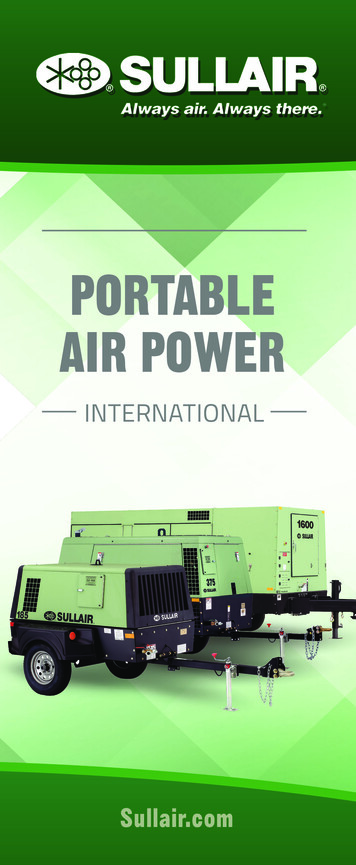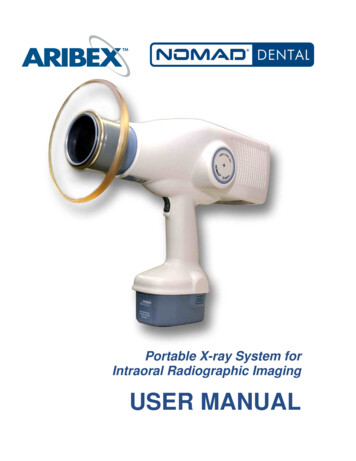
Transcription
Portable X-ray System forIntraoral Radiographic ImagingUSER MANUAL
Disclaimer: NOMAD Dental is sold with the understanding that the user assumes soleresponsibility for radiation safety (as well as any state, provincial, or local regulatorycompliance) and that Aribex, Inc., its agents or representatives, do not accept responsibilityfor:a) injury or danger to personnel from x-ray exposure,b) image overexposure due to poor operating techniques or procedures,c) equipment not properly serviced or maintained in accordance with instructionscontained in this publication, andd) equipment which has been modified or tampered with in any way.DO NOT OPERATE THIS DEVICE UNTIL YOU HAVE READ THISMANUAL and reviewed the accompanying materials.See the Certificate of Conformance accompanying your device. NOMAD Dental is also clearedby the US Food and Drug Administration (FDA) as a medical device and complies with DHHSRadiation Performance Standard, 21 CFR Subchapter J.Aribex and NOMAD are registered trademarks within the United States and other countries.NOMAD Dental, and the ARIBEX and NOMAD logos are trademarks of Aribex, Inc. worldwide.United States and international patents pending. All other brand and product names aretrademarks or registered trademarks of their respective companies.The symbols used in this publication and used to mark the equipmenthave the following meanings:Caution or Attention, review documentationIonizing RadiationElectrical Shock HazardInstructions for handling product at end of lifeDouble InsulationType BF Equipment (providing a degree of protection against electricshock, pertaining particularly to allowable leakage currents)
NOMAD USERMANUALDentalTable of Contents1.0Getting Started .1.1Intended Use .1.2Unpack, Check, and Register NOMAD .1.3Charging the Battery .11122.0Safety Precautions .2.1Radiation Safety .2.2Usage .2.3Cleaning .2.4Security, Storage, and Transportation .335663.0Setup and Check . 73.1The Backscatter Shield . 73.2Attaching a Charged Battery . 83.3Checking for Power and Adequate Charge . 83.4Optional Checks . 94.0Operation .4.1Powering Up .4.2Ensuring Battery Charge Is Adequate .4.3Ensuring the Right Exposure Time Is Set .4.4Situating the Patient and Enabling the Device .4.5Initiating and Completing an X-ray Exposure .4.6Powering Down .4.7Exposure Techniques .5.0Battery Replacement . 146.0Keeping NOMAD Up and Running .6.1Alarms and Alerts .6.2Troubleshooting .6.3Repair and Maintenance .7.0Technical Description . 207.1Basic Technical Specifications . 207.2Wiring Diagram . 217.3X-ray Tube Specifications and Characteristics . 227.4EMC Data . 247.5Optional Calibration Checks . 26101010101111111215151719Limited Warranty . 27
Thank you for choosing the Aribex NOMAD as your x-ray solution!At Aribex we value your business and we would like to hear from you, because yourfeedback or suggestions are important to us. If you have comments, please email us:NOMAD@aribex.comNOMAD Dental Features Performance – battery power source delivers dependable high voltage (60kV, true DC)and direct current (2.3mA). Consistent Emission Radiation – high-frequency, constant-potential x-ray generatorprovides high quality images, with a lower radiation dosage to the patient than standardAC x-ray systems. Radiation Protection – operator shielded from source and backscatter radiation. Simple Operation – exposure time is the only setting requiring operator input, digitallydisplayed on the user-friendly control panel along with indicators for machine and batterystatus. Lightweight and Ergonomic – design provides complete flexibility and convenience,enabling exposures without moving the patients. Exposure Safety Feature – cannot emit x-rays with insufficient voltage (low battery). Engineered for Compatibility – works with both film and digital imaging systems. Authorized Service – complete support and maintenance from Aribex and our authorizeddistributors.
USER MANUAL.1.0 Getting Started1.1 Intended UseThe NOMAD Dental X-ray System is designed to be used for both adult and pediatric patients bytrained dentists and dental technicians for producing diagnostic x-ray images.1.2 Unpack, Check, and Register NOMAD Unwrap individual components from the protective plastic and check for any noticeable signs ofdamage. The standard package system includes thefollowing items: NOMAD Device with a Backscatter Shieldattached 2 Non-Charged Batteries Battery Charger (the charger should beappropriate for local AC line voltage) Certificate of Conformance, User and BatteryCharger Manuals, Warranty Card, and NOMADOperator Training CD Preliminary Checks:ItemDevice LabelsOther LabelsCollimator ConeControl PanelTrigger SwitchDevice HousingCheckVerify that the device labels (Serial Number Label on lower side of unit infront of the handle and Warning Label on the lower side behind the handle)are legible and in place.Verify that the serial number on the Warranty/Registration card matches thedevice serial number and the device carrying case serial number.Inspect for damage. The lead lining must cover the entire interior surface.Should be smooth and free of nicks, scratches, or damage.Should move freely in when depressed and out when released.Should be free of cracks or fractures.1
NOMAD Complete the product Warranty/Registration card and mail it with proper postage to Aribex today.Completing the card fulfills a condition of warranty coverage (see the inside back cover of this manual)and enables you to receive valuable product news and updates.1.3 Charging the BatteryNOTE: Batteries are not charged at the factory and must be charged before the initial use of theNOMAD. Unwrap the power cord of the batterycharger and connect it to an AC electricaloutlet (110/120V or 220/240V, dictated bythe country/region).Position the battery charger away from thenormal patient environment. A plug adaptermay be used as needed; use only thesupplied battery charger (for manufacturerand model info, see section 6.3, Repair andMaintenance). Invert one of the batteries and carefullyplug it into the charger (do not force thebattery into the charger or damage to thebattery may result). The red indicator light on the top of the charger will flash at asteady rate while the battery is charging.The required charge time varies (normally between 30 to 45 minutes). Battery and charger maybecome warm to the touch while charging, which is a normal condition. When the battery is fully charged and ready to use, the indicator light will stop flashing andremain on continuously. Remove the charged battery and charge the second battery for future use. Optimal battery life and performance occurs when the NiCad battery is fully discharged prior torecharging. (For more information review the accompanying battery charger Instruction Manual, alsosee section 5.0, Battery Replacement.)2
USER MANUAL.2.0 Safety Precautions2.1 Radiation SafetyThis x-ray unit may be dangerous to operator and bystander unless safe exposurefactors and operating instructions are observed.Operators must follow all guidelines dictated by applicableregulations and in-house radiation protection program inregard to patients and operators who are pregnant orexpect to become pregnant.Operators must be fully acquainted with safetyrecommendations and established maximum permissibledoses.Optimal operator radiation backscatter protection existswhen:a) the operator remains within the cone-shapedbackscatter protection zone immediately behind thebackscatter shield,b) the backscatter shield is positioned at the outer end ofthe collimator cone,c) the patient tilts their head when needed toaccommodate exposures (see section 4.7), andd) the backscatter shield is close to the patient.Do not enable NOMAD until patient and operator arepositioned and ready for the exposure, diminishing thelikelihood of interruption and preventing inadvertentexposure of anyone to x-rays.Do not attempt an exposure if anyone else is in the sameroom unless it is necessary that the patient beaccompanied by another person, then that person muststay out of the direct beam and wear protective clothing.When selecting and using Position Indicating Devices(PIDs), preference should be given to models that allowthe backscatter shield to remain at the outer end of thecollimator cone for maximum operator protection.3
NOMADAn exposure can be terminated for any reason by abruptly releasing the depressed trigger (for moreinformation see section 4.0, Operation).As shown in graphic representations,maximum protection (green area) frombackscatter radiation (red area) existswhen the NOMAD is positioned nearthe patient, is perpendicular to theoperator (with the patient’s head tilted ifneeded), and the backscatter shield isfully extended toward the patient.Operation outside the protection zone(or with a diminished protective zone)requires proper precautions such as theuse of lead aprons.Proper postioningMAXIMUMPROTECTIONDo not operate with the backscatter NOMAD held backshield removed!Shield slid backNon-perpendicularMINIMIZED PROTECTIONNOTE: In implementing a radiation protection program, please consult all applicable (state, provincial, and local) regulationsgoverning radiation protection and the use of x-ray equipment, and ensure full compliance with any such regulations.Comparative Data for Whole Body Exposure (Annual)150mSvRecommended Occupational Limit5mSvOccupational Limit Requiring Dosimetry3.65mSvAverage Background Radiation2.19mSvAverage Occupational Radiation Exposure for Flight Crews0.02–0.70mSvRange of Exposure for Dental Personnel Using Conventional X-rays0.30mSvAverage Exposure Using NOMAD with D-Speed Film0.12mSvAverage Exposure Using NOMAD with F-Speed Film or Digital Sensor1341) Standards for Protection against Radiation, 10 CFR 20 (US Federal Standards), 19942) NCRP Report No. 145 (National Council on Radiation Protection and Measurements), p73) "Estimated Cosmic Radiation Doses for Flight Personnel", Feng YJ et al, Space Medicine and Medical Engineering, 15(4) 2002, p265-94) NCRP Report No. 145, p95) Normalized average assumes 7,200 exposures per year, and the average length of exposure for D-speed 0.50 seconds, F-speed 0.25seconds, digital sensor 0.20 seconds4255
USER MANUAL.Comparative Data for Hand and Extremity Exposure (Annual)1500mGyRecommended Occupational Limit50mGyOccupational Limit Requiring Dosimetry0.18mGyv0.07mGyAverage Exposure Using NOMAD with D-Speed Film122Average Exposure Using NOMAD with F-Speed Film or Digital SensorX-RAY SOURCEFOCAL SPOTBACKSCATTERRADIATIONSHIELDINGFIXED BEAMLIMITINGDEVICE1) Standards for Protection against Radiation,10 CFR 20 (US Federal Standards), 19942) Normalized average assumes 7,200 exposuresper year, and the average length of exposure forD-speed 0.50 seconds, F-speed 0.25 seconds,digital sensor 0.20 secondsGEOMETRICALRADIATION FIELDDUE TO BEAMLIMITING NSOURCE TOSKINDISTANCEPATIENTPLANE2.2 UsageAs a safety feature, NOMAD will not emit x-rays with insufficient voltage (low battery).The NOMAD is also designed to avoid damage from overheating. The minimum duty cycle rating (therelationship between duration and frequency of exposures) is 1:60. Examples of optimal use:DurationCycle0.25s0.46s0.50s0.99sEvery 15 secEvery 28 secEvery 30 secEvery 60 secDo not operate NOMAD or the battery charger if either was immersed in liquid orsubjected to an undue amount of moisture.5
NOMAD There are no user serviceable parts inside the NOMAD. Do not open the device housing. Doing so will void the warranty. NOMAD should not be used in environments where flammable cleaning agents arepresent. Locate the battery charger away from the normal patient environment (see section 5.0,Battery Replacement).2.3 Cleaning Turn off the power and detach the battery before cleaning. Ensure the battery charger is unpluggedbefore attempting to clean it. Use a non-acetone based disinfectant wipe or a cloth to wipe the exterior surfaces of the NOMADand charger.NOTE: NOMAD and the accompanying battery charger are not designed to be subjected to any kind ofsterilization procedure.2.4 Security, Storage, and Transportation NOMAD must be kept in a secure location, such as a locked cabinet, when not in use to preventunauthorized access. The battery serves as the device security key. When finished with NOMAD for the day, detachthe battery and lock it away in a separate location to prevent unauthorized use. Make sure NOMAD will not be knocked to the ground when not in use. Lay it on its side ifnecessary. Power will automatically shut off after a period of inactivity (approximately 2.5 minutes). Some battery charge is lost during extended inactivity (leading to fewer exposures between thebattery charging). Do not store or carry batteries so that metal objects can contact exposed battery terminals.6
USER MANUAL. Do not store the NOMAD, battery charger, or batteries in extreme conditions: below –20 C / –4 For above 40 C / 105 F, or beyond 95% relative humidity (non-condensing). This storage locationshould be cool, dry, and away from direct sunlight.3.0 Setup and Check3.1 The Backscatter ShieldIn addition to the lead-lined cone, the backscatter shield provides additional protection to you, theoperator, and features an adjustable position to permit exposures made at various angles. Ideally, the shield should remain fully extended tothe outer edge of the cone, as close to the patient aspossible for each image taken (see 2.1, RadiationSafety). You may find that the backscatter shield needs tobe adjusted to accommodate position indicatingdevices or angled exposures. If adjustments areneeded, stand the NOMAD on-end on a stable surfaceand, while holding the backscatter shield perpendicularto the collimator cone (tube-shaped cone), gently glidethe shield up or down along the cone using equalpressure to maintain a perpendicular alignment andavoid binding. To keep the shield securely on the cone a retainero-ring is permanently attached in the groove at theouter cone end. Do not attempt to remove this o-ringor to remove the backscatter shield, attempting to doso will result in damage to your device.7
NOMAD3.2 Attaching a Charged Battery Properly orient and carefully insert the newly chargedbattery into the base of the NOMAD handle, (a properlyoriented battery should click into place without force, forcingthe battery into position may damage the battery and/or theNOMAD). The clicking sound ensures the snaps on both sidesof the handle bottom are fastened. Make sure the battery is secure by giving it a tug.NOMAD can be placed into service after the check for power(section 3.3). Read the battery charger instruction manual for completeinformation on how to achieve the longest life and bestperformance from your batteries.3.3 Checking for Power and Adequate ChargeNOMAD Control Panel After inserting a fully charged battery,press and release the POWER button. Thenumeric (LED) display should illuminate,accompanied by a single, long audiblesignal . Check for adequate battery charge bymaking a non-patient test exposure, in aprotected area so that it will not result inbystander or operator exposure. If the battery is too low, the yellow LOWBATTERY indicator at the lower right of thecontrol panel will flash (accompanied by anintermittent audible signal ).8
USER MANUAL. Once a battery is depleted, indicated by the LOW BATTERY alert, it must be recharged before use. For continued use, insert the secondary, replacement battery (which should be charged inadvance).NOTE: See section 5.0, Battery Replacement, for more information.3.4 Optional ChecksThe NOMAD is factory calibrated and tested prior to release (see your Certificate of Conformance),there are no adjustment options. However, the optional checks listed below may be performed by aqualified technician as desired.Test firing this x-ray unit may be dangerous to the testing technician or bystandersunless safe test exposure techniques are used such as the use a lead lined cap to coverthe end of collimator or test firing in a protected area.ON/OFF Switch: Install fully charged battery to NOMAD device. Press the POWER button and verify theON and OFF conditions.Increase/Decrease Switch (Up and Down Arrows): With the device turned ON, press each of theIncrease then Decrease buttons and verify that the exposure times as displayed on the LED displaychange appropriately.Enable Switch: With the device turned ON and the LED
USER MANUAL. 1 1.0 Getting Started 1.1 Intended Use The NOMAD Dental X-ray System is designed to be used for both adult and pediatric patients by trained dentists and
